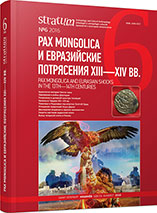Завоевание поздневизантийской Таврики монголами: историко-археологический контекст катастрофы последней четверти XIII века
The Conquest of Late Byzantine Taurica by the Mongols: historical and archaeological context of the disaster of the last quarter of the 13th century
Author(s): Victor L. MytzSubject(s): History, Archaeology, Military history, Middle Ages, 13th to 14th Centuries
Published by: Издательский дом Stratum, Университет «Высшая антропологическая школа»
Keywords: Late-Byzantine Taurica; 13th century; Mongol conquest fire layer; closed assemblages; amphorae; glazed ceramic ware; numismatic finds
Summary/Abstract: The time and the cause of the disaster that befell the Late-Byzantine Taurica in the 13th century have been the matter of discussion among the researchers of medieval Crimea for over 100 years. In the course of archaeological excavations of the late 19th —20th centuries, the layers of total fire and destructions have been discovered on seven large and small urban centers of the peninsula: Chersonese, Sogdia, Eski-Kermene, Suiren, Tepe-Kermen, Bakla and Alushta. On the territory of five medieval cities (Mangup, Symbolon, Partenit, Solkhat and Vosporo), the redeposited material of the 13th century with some evidence of the second burning, i. e. exposure to fire, has been identified. Researchers have proposed various dates and causes for destruction of the Byzantine sites in Taurica. Among these causes, the attack of the Seljuks in 1223 was suggested, but mostly the raids of the Tatars, which according to written accounts, were made in 1223, 1238, 1249, 1298/99. Since 50—60s of the last century, historiography has been dominated by A. Jacobson’s standpoint. It says that the Byzantine Taurica was defeated by Nogai Khan in 1299. Early dates (1220—1240s) contradict the description of “Gazaria” made by Guillaume de Rubruk, who arrived in Sogdia in May, 1253. According to Rubruk’s account, there are 40 more fortresses between Kherson and Sogdia. In addition, some researchers have noticed that in the fire layers there were no coins of 1270—1290s, and therefore, the destructions occurred no later than in 1270s. One of the comments on the margins of Sogdian Synaxar there is a record about the murder of all Sogdian inhabitants by the Tatars in May 28, 1278. It is likely that this comment tells about the time when the Mongols destroyed cities, fortresses, monasteries and settlements of the Late-Byzantine Taurica. The events of the 1298—1299 civil war in the Ulus of Jochi are highlighted in the written sources in much detail. By that time many cities, fortresses and monasteries of Taurica had already laid in ruins after the pogrom in 1278, which is why the coins of 1270—1290s could not be deposited on their territories (in the fire layers).
Journal: Stratum plus. Археология и культурная антропология
- Issue Year: 2016
- Issue No: 6
- Page Range: 69-106
- Page Count: 38
- Language: Russian
- Content File-PDF

